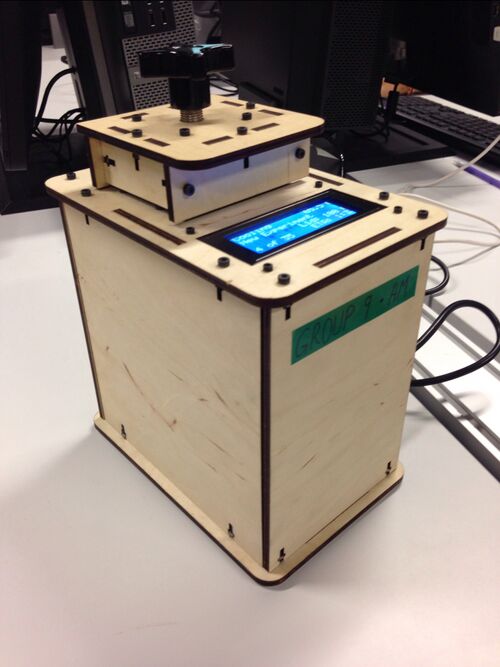BME100 f2013:W900 Group9 L6
| Home People Lab Write-Up 1 | Lab Write-Up 2 | Lab Write-Up 3 Lab Write-Up 4 | Lab Write-Up 5 | Lab Write-Up 6 Course Logistics For Instructors Photos Wiki Editing Help | ||||||
OUR COMPANY
Our product: The AccuResults PCR Test
LAB 6 WRITE-UPComputer-Aided DesignTinkerCAD TinkerCAD is a free online tool used to create 3D models. TinkerCAD was used to optimize the rendering of the current PCR tubes. The software allows making changes to shape, color, text, etc. Common usage of the TinkerCAD software is to create a design of a 3D object which can then be sent to a 3D printer. What our group did to improve the PCR tubes was we added labels to each separate tube to make sorting easier. We also added a small mechanism on the lid of the tubes for a vacuum pipe to be inserted. This way the PCR tubes can be air tight.
TinkerCAD can be used to create and modify virtually anything, including the camera holder used to keep smartphone cameras steady in the experiment. For example, TinkerCAD can modify the dimensions of the slot for the phone, allowing custom holders to be printed for any brand or type of smartphone. The angle of the slot can be modified as well, in order to keep the phone at a perfect 90° angle to the table. TinkerCAD creates a virtual model, and that model could then be printed using a variety of materials.
Feature 1: Cancer SNP-Specific PrimersBackground on the cancer-associated mutation Nucleotides are the building blocks of organic life at the cellular level. They make up nucleic acid, and are composed themselves of a nitrogenous base, a 5-carbon sugar, and a phosphate group. The four kinds of nucleotide bases are adenine (A), cytosine (C), guanine (G), and thymine (T). Each can base-pair with one other base (A-T and C-G). A single nucleotide polymorphism (SNP) is a variation in an individual nucleotide in a gene sequence. This is due to the existence of two or more alleles, which are alternate variations of a gene. Although this change occurs at a single nucleotide, the overall results can be catastrophic to the organism. For example, the rs17879961 SNP is the gene variation that codes for cancer. It affects the gene CHEK2 (which stands for checkpoint kinase 2) and is located on chromosome 22. The cancer-associated allele contains the base sequence ACT, as opposed to the standard ATT.
How the primers work: The primers will only attach to specific sites on the DNA strands. Therefore, it is important to determine those sites, specifically for the cancer-associated SNP. In this case, the cancer associated allele will contain ACT (seen at the beginning of the forward primer sequence) and allow the primer to attach to all nucleotides in the sequence. If the gene contains the standard ATT instead, the primer will not attach to the sequence. This allows only the cancer-associated sequence to be amplified rather than the sequence with the non-cancer allele.
Feature 2: Consumables KitThe Consumables Kit will be packaged much like it already is. There will be sterilized, ordered tips in a sealed rack that are ready for use. Along with the tips, the micropipettor is accurate as is and will have no changes made to the actual device. The goal is to keep the new devices as simple to use as the ones that are already use, so the consumer has no issues adjusting. The only difference in the Consumables Kit is the material of the tips. The tips will still be made of plastic, but they will be covered in a hydrophobic material on the inside to ensure all the liquid is being released while pipetting. This will give the already accurate devices an even smaller margin for error. As for the issue of waste, there is not much that can be done without sacrificing the sterility of the tips. The tips will still have to be changed after each use.
Feature 3: PCR Machine Hardware
The PCR machine is a vital tool to have in lab because when working with DNA it is not easy to receive DNA from the desired target. This means that even a small amount of DNA would be sufficient enough to test with and to attain accurate results with. The PCR machine allows labs to run tests efficiently yet still attain correct results.
Feature 4: Fluorimeter HardwareThe Fluorimeter will be packaged in the box that will be used to block out the light when actually using the device. The main purpose of this is for easy storage. The package will include in it the actual Fluorimeter, a detachable adjustable stand, a cell phone stand, and five hydrophobic slides. The device will also come with the charged battery in it for consumer convenience. The biggest variable that can cause error when using the Fluorimeter is the camera angle. Since there are multiple phones out there with different placements of their cameras, the results could be altered based on the angle the camera makes with the Fluorimeter. To ensure this doesn't happen, the new Fluorimeter will have an adjustable stand on the bottom to raise or lower the height of the actual hardware to fit the cell phone's camera height. This allows for any camera to have a perfectly level view with the drop and the blue light, which will give accurate results.
Bonus Opportunity: What Bayesian Stats Imply About The BME100 Diagnostic ApproachBayesian statistics are useful in determining whether or not results are conclusive. In this experiment, Bayesian stats can be used to figure out how reliable the PCR procedure was at determining whether a patient had cancer or not. Based on the Bayesian statistics for calculations 3 and 4, it can be determined that CHEK2 PCR has a low sensitivity, but a high specificity when predicting cancer. The CHEK2 PCR has a low sensitivity because the Bayesian calculations resulted to a very small number. Low sensitivity refers to a low probability that the person with the disease that is being tested will give a positive result. Having a low sensitivity is bad because it can cause the results to be a falsely negative, which means the patient will think they don't have the disease being tested, but they really do. However, the CHEK2 PCR also has a high specificity in the prediction of cancer because the Bayesian statistics yielded a number of more than one. This means that there is a high chance that a person who gives a negative result doesn't have the disease, and their negative is a true negative. Therefore, the CHEK2 PCR is very accurate and reliable when testing people without the disease, but leaves large room for error when testing people with the disease. Thus, the results are inconclusive to a degree, since the whole point of the test is to see if the patient has cancer and would need to undergo treatment before it progresses. If they are given a false negative, they won't know that they need treatment. The phrase "to a degree" was used since the test is also used to determine if a patient does not have cancer, which the CHEK2 PCR is accurate at determining. |
||||||






